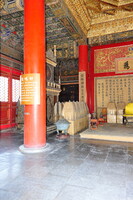Forbidden City: Hall of Union (Jiao Tai Dian)
unknown (Chinese)

Download1A2-CH-B-FC-HUP-A11_cp.jpg (540.8Kb)
Alternative Titles
交泰殿
Hall of Union (Jiaotai dian)
Date
1421Description
Interior of the Hall of Union, to the left of the throne of the Empress; The Forbidden City was the Chinese imperial palace from the Ming Dynasty to the end of the Qing Dynasty. The Inner Palace, on the main axis north of the five-bay Gate of Heavenly Purity (Qianqing men), was a more private part of the Forbidden City. The three inner halls mirror the three great halls of state in the front precinct: the Palace of Heavenly Purity (Qianqing gong), the emperors’ living quarters during the Ming period; the small, square Hall of Union (Jiaotai dian); and the Palace of Earthly Tranquillity (Kunning gong), the living quarters of the Ming empresses. The Hall of Union, the empress’s throne-room, is square and heavy, with solid masonry walls and a single-eaved roof. Source: Grove Art Online; http://www.oxfordartonline.com/ (accessed 5/11/2011)
Type of Work
throne room; reception room; historic site; capital citySubject
architecture, decorative arts, historical, rulers and leaders, Chinese, Ming, Qing
Rights
Rights Statement
Licensed for educational and research use by the MIT community only